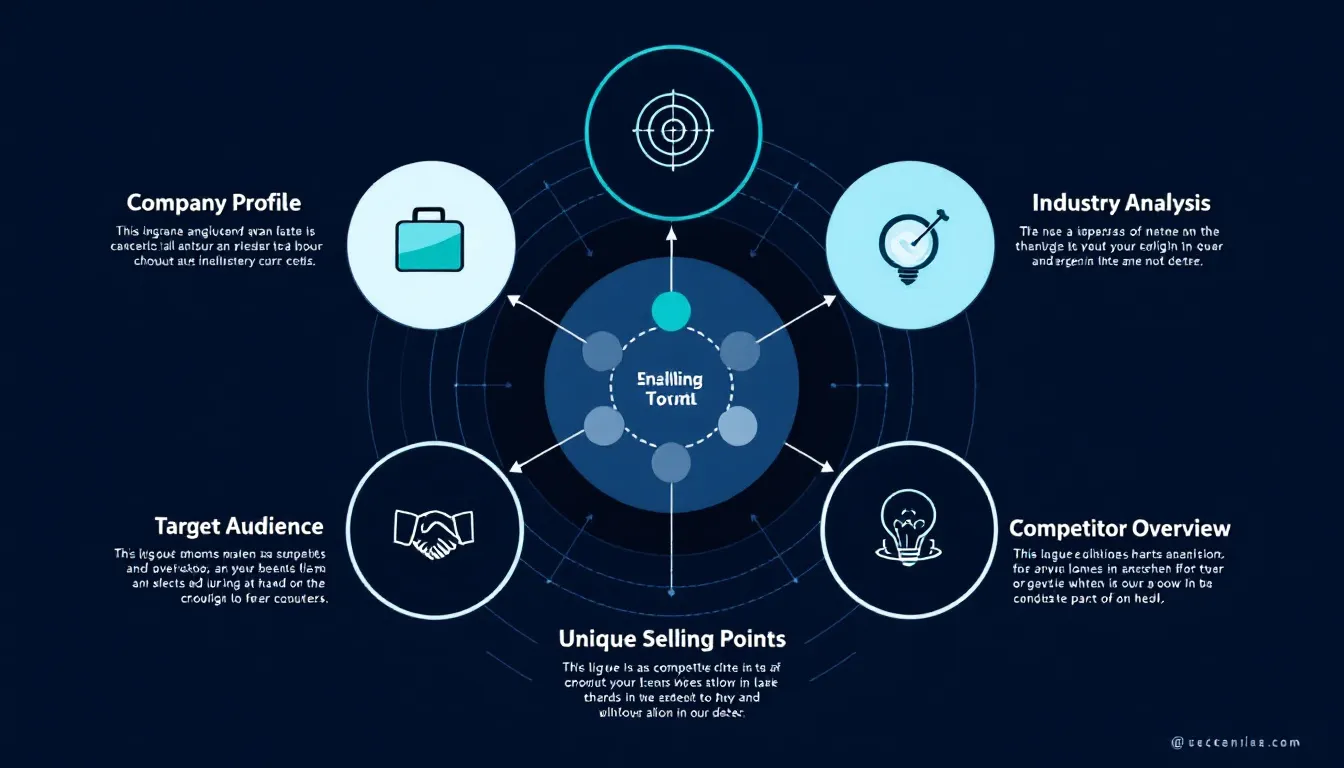Is this tool helpful?
How to Use the Competitive Analysis Tool Effectively
Our competitive analysis tool helps businesses gain valuable insights into their market position by analyzing top competitors and identifying opportunities for improvement. Here’s a detailed guide on using each field effectively:
1. Company Name Input
Enter your business name in the designated field. Examples:
- GreenTech Solutions International
- Urban Fitness Revolution
2. Industry Selection
Specify your business sector as precisely as possible. Examples:
- Sustainable Energy Solutions
- Boutique Fitness Services
3. Target Audience Description
Detail your ideal customer profile with demographic and psychographic information:
- Environmentally conscious homeowners, age 35-65, middle to upper-income bracket
- Health-focused urban professionals, age 25-45, interested in personalized fitness solutions
4. Competitor List
Input your top three competitors, one per line. Include direct competitors operating in your market space. Examples:
- For GreenTech: SolarCity, Vivint Solar, Sunrun
- For Urban Fitness: Orangetheory Fitness, F45 Training, Barry’s Bootcamp
5. Unique Selling Points (Optional)
List your key differentiators and competitive advantages. Examples:
- Proprietary energy monitoring technology, certified green installations, lifetime warranty
- AI-powered workout customization, nutrition coaching integration, flexible class scheduling
Understanding Competitive Analysis and Its Importance
Competitive analysis is a strategic tool that enables businesses to evaluate their market position, identify gaps in competitors’ offerings, and develop effective strategies for differentiation. This tool streamlines the analysis process by focusing on key aspects of competitive intelligence.
Core Components of Competitive Analysis
- Market positioning assessment
- Competitor strengths and weaknesses evaluation
- Target audience alignment
- Unique value proposition identification
- Strategic opportunity discovery
Benefits of Using the Competitive Analysis Tool
1. Strategic Decision Making
The tool provides structured insights that inform:
- Product development priorities
- Marketing message refinement
- Resource allocation decisions
- Market positioning strategies
2. Time and Resource Optimization
Automated analysis saves valuable time and resources by:
- Streamlining competitor research
- Generating actionable insights quickly
- Providing structured competitive intelligence
3. Market Opportunity Identification
The tool helps uncover:
- Underserved market segments
- Service gaps in competitor offerings
- Potential areas for innovation
- Unique market positioning opportunities
Practical Applications and Use Cases
Case Study 1: E-commerce Business
An online retailer used the tool to analyze competitors and discovered:
- Gaps in competitors’ shipping policies
- Opportunities in customer service enhancement
- Unique product bundling possibilities
Case Study 2: Professional Services Firm
A consulting company leveraged the tool to:
- Identify niche market opportunities
- Develop specialized service packages
- Create unique client engagement models
Problem-Solving Capabilities
1. Market Positioning Challenges
The tool helps businesses:
- Define clear market differentiation
- Identify competitive advantages
- Develop unique value propositions
2. Target Audience Alignment
Users can:
- Validate target market selection
- Identify audience overlap with competitors
- Discover underserved customer segments
Implementing Insights from the Analysis
Strategic Action Planning
Transform analysis results into actionable steps:
- Prioritize improvement areas
- Develop competitive response strategies
- Create implementation timelines
- Allocate resources effectively
Monitoring and Adjustment
Regular competitive analysis helps:
- Track market changes
- Assess strategy effectiveness
- Adapt to competitive moves
- Maintain market relevance
Frequently Asked Questions
How often should I conduct competitive analysis?
Regular analysis is recommended, typically quarterly for most industries. However, fast-moving sectors may require monthly updates to stay current with market changes.
Can I analyze more than three competitors?
While the tool focuses on your top three competitors for targeted insights, you can run multiple analyses to cover additional competitors and compile comprehensive market intelligence.
How do I identify my main competitors?
Focus on businesses that:
- Serve similar target markets
- Offer comparable products or services
- Compete for the same customer base
- Operate in your geographic area or online space
What makes a good unique selling point?
Effective USPs should be:
- Clearly differentiated from competitors
- Valuable to target customers
- Sustainable and defensible
- Authentic to your brand
How can I best utilize the analysis results?
Maximize the value of your analysis by:
- Sharing insights with key stakeholders
- Incorporating findings into strategic planning
- Creating action plans for implementation
- Regularly reviewing and updating strategies
What if my industry is unique or niche?
The tool’s flexible design accommodates various industries and business models. Focus on describing your specific market context and competitive landscape to receive relevant insights.
Important Disclaimer
The calculations, results, and content provided by our tools are not guaranteed to be accurate, complete, or reliable. Users are responsible for verifying and interpreting the results. Our content and tools may contain errors, biases, or inconsistencies. We reserve the right to save inputs and outputs from our tools for the purposes of error debugging, bias identification, and performance improvement. External companies providing AI models used in our tools may also save and process data in accordance with their own policies. By using our tools, you consent to this data collection and processing. We reserve the right to limit the usage of our tools based on current usability factors. By using our tools, you acknowledge that you have read, understood, and agreed to this disclaimer. You accept the inherent risks and limitations associated with the use of our tools and services.







